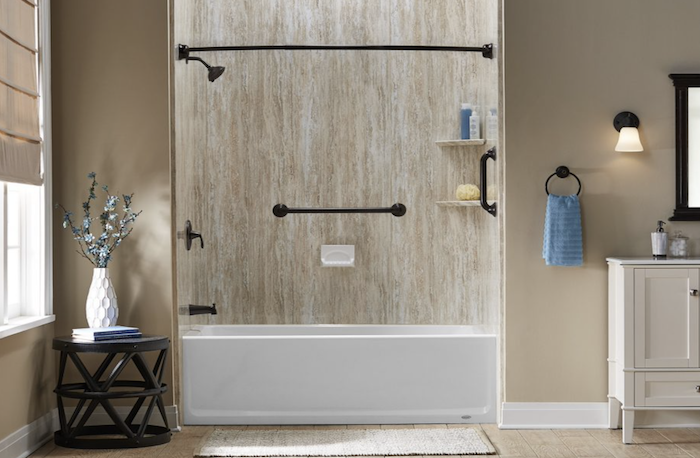Aging-in-Place Bathroom Design

April 18, 2023
If you’re a designer, you are one of the first people a homeowner will meet when they are considering a bathroom renovation. While it can be tempting to say all the right things to make the sale, great designers understand their work is so much more than closing a deal. As the population of older adults continues to increase, designers can help clients consider modifications to maintain their independence and dignity for as long as possible by understanding aging-in-place bathroom design.
An estimated 75 million people are expected to retire by 2030, a time frame being coined The Great Retirement. Additionally, AARP reported in a 2019 survey that 75% of baby boomers have not planned for healthcare costs as part of their retirement savings, including long-term care facilities. That makes it even more important to allow them to age in place as long as possible, requiring modifications to their current homes to ensure safety.
Understanding Your Client
One way you can go about ensuring clients feel comfortable with the changes happens during the discovery phase. Great designers seek to understand what the pain points are for the customer and ensure they fully understand the individual’s needs and goals. They should learn how long they plan to live in their home, how they are currently ensuring safety when getting in and out of their tub and assess how safe they feel. Then, you should create a customized inspection report to address those safety concerns.
One of the most common updates required is in their bathrooms. While many homes were designed with half-wall tubs to serve young and growing families, many clients will require a low-step or no-step shower as they age. They will need an updated shower to make it safer for their long-term needs. For an older individual on a limited income, a big change and financial cost like this can be daunting. That’s why it’s important for designers to go the extra mile to explain the benefits of these types of changes and ensure clients feel comfortable with both the design and the installation process.
Taking Aging-in-Place Design to the Client
A compassionate designer will make the process of planning for these aging-in-place bathroom changes as easy as possible. By using 3D rendering of a project, they can show clients what their new shower will look like when it’s completed and provide accurate costs for the work to reach the desired outcome.
Additionally, any questions about the installation process can be addressed through an installation video that outlines what this process is like. The video will show the uninstallation of an old tub and the new installation of the low-step shower. By seeing this process play out in a video, customers find a sense of calm once they understand what to expect.
Designers should also consider the hardware needed to make the shower more accessible for the customer. This means bringing in samples of grab bars and demonstration kits that will allow people to touch and interact with the accessories they can choose for their shower.
Third, by marking where things will go with blue tape, designers help clients understand what will need to be moved or adjusted to make the installation work. This helps visualize how their current bathroom will change within the space.
Growing old is a natural process, and the most you can hope for is that you can maintain your independence as long as possible. Great designers understand that as people age, staying in one’s home becomes more of a privilege and more of a challenge.
By keeping this in mind and remaining cognizant of compassionate design, you can make a difference for individuals reclaiming their independence. It’s a career that is rewarding beyond measure, and, as the population continues to age, the work designers do has never been more important than it is today.
—By Joseph Moran, vice president of sales at Tundraland Home Improvements, a LEAF Home remodeling company
More News
April 26, 2024 | Business, Trends & Inspirations
Personalization Is Defining Today’s Luxury Projects
April 26, 2024 | Business
PIRCH Permanently Shuts Down, Files for Bankruptcy
April 25, 2024 | Awards & Events
2024 Coverings Installation & Design Award Winners Announced
April 24, 2024 | People
Oatey Announces New COO and CCO
April 23, 2024 | Trends & Inspirations
Sustainability Report: More Education Needed for Green K&B Design
April 2, 2024 | Sponsored
Whirlpool Corp. Brings Purposeful Innovation Home